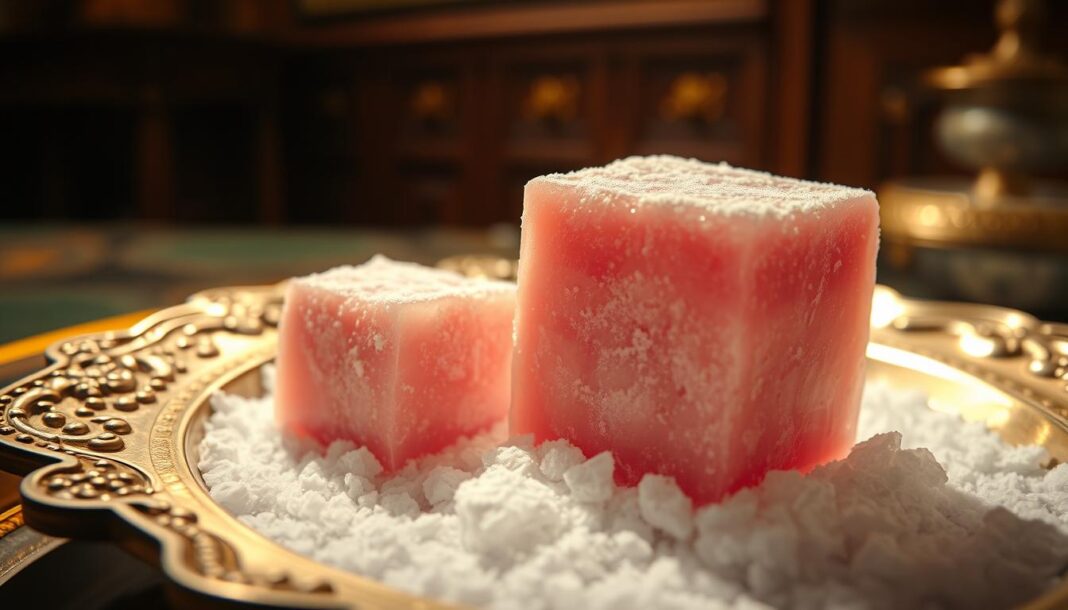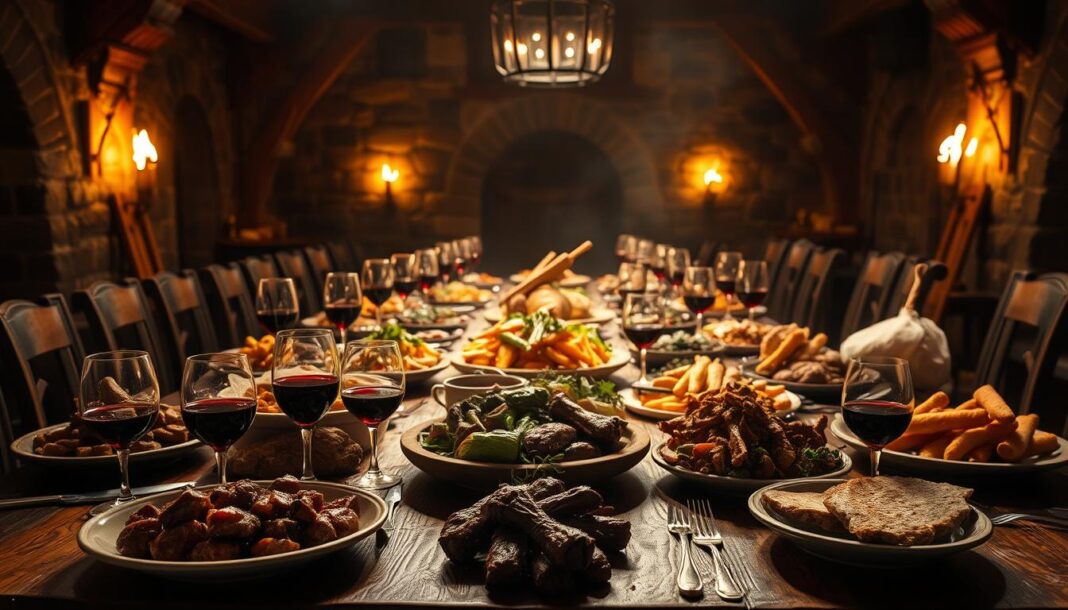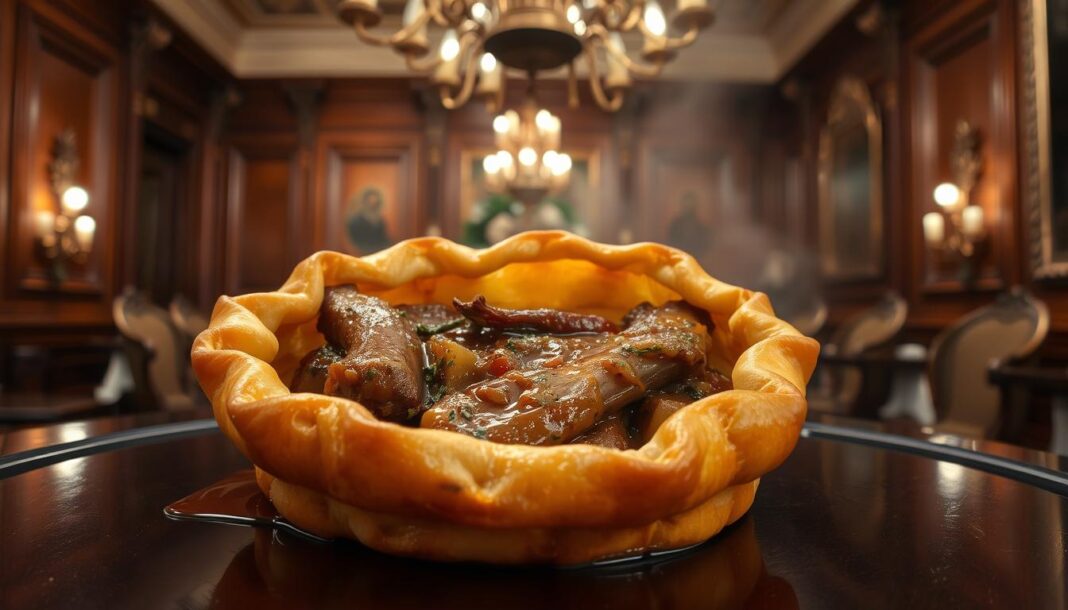C.S. Lewis’s The Lion, the Witch and the Wardrobe has captivated readers for generations with its rich narrative and symbolic elements. One of the most intriguing aspects of this beloved tale is the Turkish Delight, a sweet treat that plays a pivotal role in the story. The White Witch’s offering of this enchanted confection to Edmund Pevensie is a memorable moment that has sparked curiosity among readers about its significance and historical context.
We will explore how Turkish Delight became an iconic element in the Chronicles of Narnia, representing temptation and betrayal. This sweet treat serves as both a plot device and a powerful symbol, captivating readers’ imaginations and leaving a lasting impression.
Key Takeaways
- Turkish Delight is a significant element in “The Lion, the Witch and the Wardrobe,” symbolizing temptation and betrayal.
- The White Witch uses Turkish Delight as a tool of manipulation, creating a pivotal moment in the narrative.
- The historical context of Turkish Delight adds depth to its role in the story, reflecting its origins and cultural significance.
- C.S. Lewis chose Turkish Delight for its symbolic value and cultural intrigue, enhancing the narrative’s richness.
- The treat represents false promises and luxury in a barren world, mirroring Edmund’s inner conflict.
The Magical Allure of Turkish Delight in Narnia
In the world of Narnia, Turkish Delight is more than just a sweet treat; it’s a symbol of the White Witch’s power to corrupt and deceive. The White Witch uses this enchanted confectionery to tempt Edmund Pevensie, exploiting his childish desires and ultimately leading him to betray his siblings.
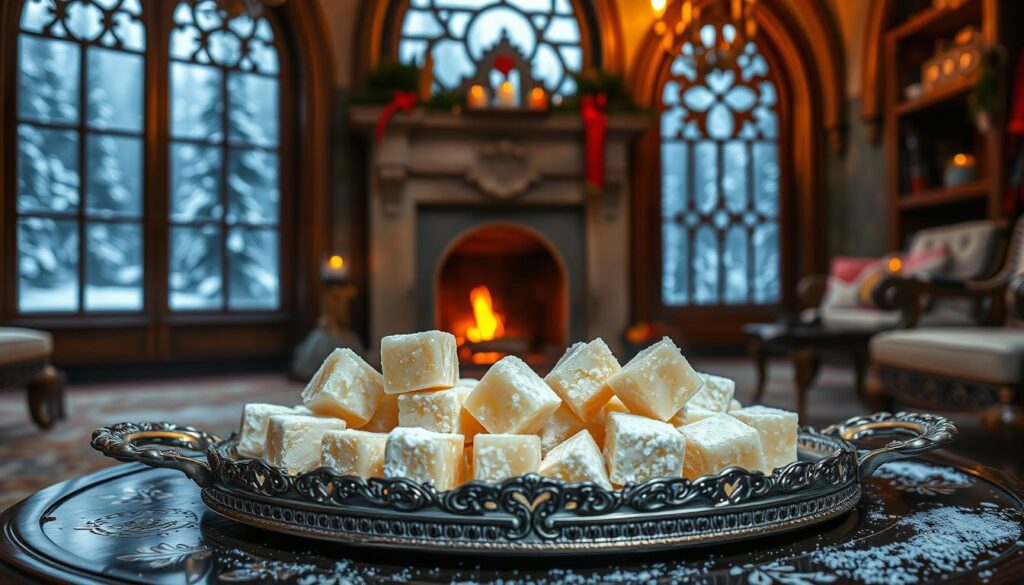
Edmund’s Temptation and Betrayal
The White Witch’s strategic use of Turkish Delight as an instrument of seduction is a pivotal element in the narrative. By offering Edmund this extraordinary candy, she awakens his desire for power and luxury, leading him down a path of betrayal. The Turkish Delight becomes a powerful symbol of temptation, echoing biblical parallels where forbidden sweets lead to transgression.
Symbolism of Food in The Chronicles of Narnia
C.S. Lewis often uses food as a vehicle for deeper theological and moral lessons. In the context of wartime rationing in Britain, the luxurious and exotic nature of Turkish Delight made it particularly appealing. The mixture of sugar and exotic flavors in this confectionery makes it a perfect literary device, symbolizing both the allure and the danger of unchecked desires.
| Symbolism | Representation in Narnia | Significance |
|---|---|---|
| Turkish Delight | Temptation and Deception | Leads to Edmund’s betrayal |
| Food | Moral and Theological Lessons | Represents desires and consequences |
| Sugar and Exotic Flavors | Luxury and Allure | Appeals to Edmund’s desires |
What Is Turkish Delight? The Real-World Confection
The enchanting world of Turkish Delight, known locally as lokum, is a realm where sugar, starch, and flavor converge. This traditional confection has been a staple of Turkish culture for centuries, captivating the hearts and taste buds of many.
Turkish Delight is made from a gel created by heating sugar and starch, resulting in a texture that is somewhere between gumdrops and Jell-O. Despite its high sugar content, the starch helps to mellow out the taste, allowing the citric acid and various extracts to shine through. Traditionally, Turkish Delights are made from lokum, which is prepared by heating sugar syrup and a cornstarch slurry mixture until it thickens into a gel. This gel is then flavored, often with rosewater, and sometimes includes add-ins like pistachios or walnuts.
Origins and Traditional Preparation
Turkish Delight, or lokum, has its roots in Ottoman cuisine, where it has been a beloved confection for centuries. The traditional preparation method involves a careful balance of sugar syrup and starch to create the distinctive gel-like consistency that sets Turkish Delight apart from other candy. The process of making proper lokum requires patience and precision, as the sugar mixture must reach exact temperatures and consistency to achieve the perfect texture.
| Ingredient | Role in Turkish Delight | Common Variations |
|---|---|---|
| Sugar | Provides sweetness and texture | Granulated sugar, sugar syrup |
| Starch | Helps to create the gel-like texture | Cornstarch, potato starch |
| Flavorings | Adds unique flavors to the lokum | Rosewater, lemon, orange, pistachio |
The labor-intensive process and the use of high-quality ingredients contribute to the unique character of Turkish Delight. The classic rosewater flavoring gives traditional lokum its distinctive floral character, though numerous variations exist, including those with pistachios, hazelnuts, and citrus flavors.
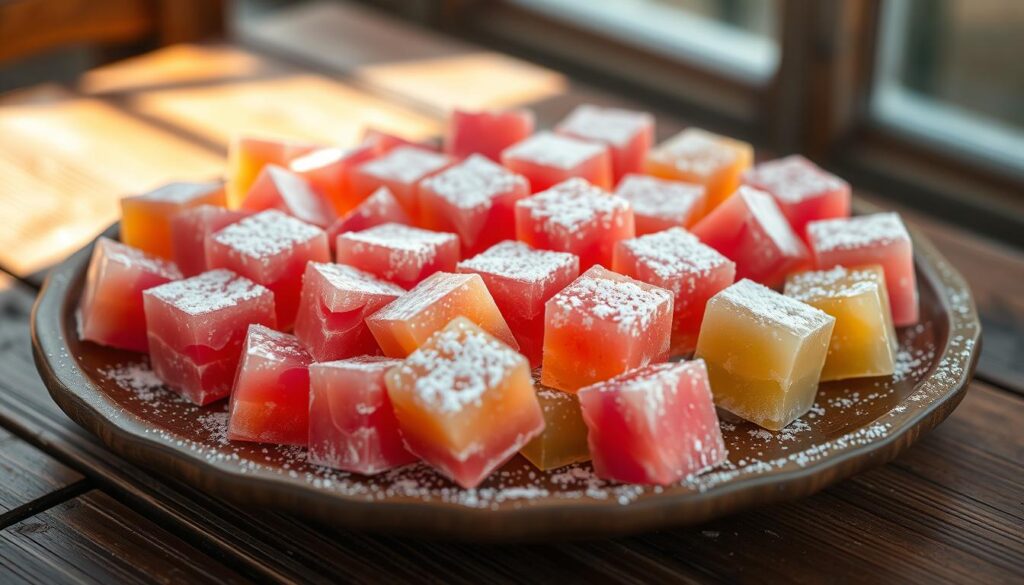
Lokum: The Authentic Turkish Sweet
The authentic Turkish sweet, lokum, differs significantly from Western interpretations, particularly in terms of texture, flavor complexity, and cultural significance. In Turkish culture, lokum is more than just a sweet treat; it’s a symbol of hospitality, often served with coffee or tea to honored guests.
The historical trade routes that introduced exotic ingredients like rose essence to Turkish cuisine played a crucial role in the development of this distinctive sweet. Modern commercial versions of Turkish Delight often fail to capture the subtle balance of sweetness and flavor that makes authentic lokum so special.
The Lion, Witch, Wardrobe Turkish Delight: Fiction vs. Reality
C.S. Lewis’s depiction of Turkish Delight in ‘The Lion, The Witch, and The Wardrobe’ has become an iconic element of the narrative, but how does it compare to the real confection? The allure of this sweet treat in the story has captivated readers for generations, yet it also raises important questions about the intersection of literature and culinary culture.
Portrayal of the Sweet
C.S. Lewis’s portrayal of Turkish Delight was likely influenced by its exotic appeal to British readers of his time. The magical version described in the book is enchanted, making it more than just a simple candy – it’s a tool of temptation that leads to Edmund’s betrayal. Lewis needed a sweet that was both recognizable and exotic, and Turkish Delight fit the bill perfectly. The description emphasizes its tempting qualities, focusing on its sugar-laden nature, which omits the subtle complexity of real lokum.
The mixture of fact and fiction in Lewis’s portrayal demonstrates how food can become mythologized through literature, taking on symbolic meanings beyond its actual taste or preparation. The water-based syrup and starch preparation of real lokum creates a texture and experience quite different from what many readers imagine when reading the Narnia books.
Cultural Misconceptions and Literary License
Many readers’ first exposure to Turkish Delight comes through the Chronicles of Narnia, creating expectations that may not align with reality when they finally taste the actual confection. The cultural perception of Turkish Delight in Western countries has been shaped more by Lewis’s fiction than by authentic Turkish culinary traditions. Key differences include:
- The authentic lokum is often flavored with rosewater, lemon, or other subtle flavors, unlike the heavily sugared version in the narrative.
- The texture of real Turkish Delight is typically soft and slightly sticky, not the hardened, enchanted confection described in the book.
- Lokum is usually enjoyed as a sophisticated treat, often served with coffee or tea, rather than as a standalone temptation.
By examining the differences between the fictional Turkish Delight and its real counterpart, we gain insight into how literature can influence our perceptions of cultural delicacies and the importance of understanding the context behind culinary descriptions in fiction.
Making Your Own Narnia-Inspired Turkish Delight
With a few simple ingredients and some patience, you can craft your own Turkish Delight, just like the White Witch’s tempting treats in The Lion, the Witch, and the Wardrobe. This traditional confection, also known as lokum, has been a delight for centuries, and its preparation is an art worth mastering.
Essential Ingredients and Equipment
To make authentic Turkish Delight, you’ll need a few key ingredients: sugar and water to create a syrupy base, cornstarch slurry to thicken and solidify the lokum, and flavorings like rosewater (though you can experiment with other extracts). Powdered sugar is essential for dredging the Turkish Delights, giving them their characteristic snowy coating. Additionally, having a candy thermometer handy is crucial for accurately measuring the temperature of the mixture, which is vital for achieving the perfect consistency.
- Sugar and water for the syrupy base
- Cornstarch slurry for thickening
- Rosewater or other flavorings
- Powdered sugar for dredging
- Citric acid to balance sweetness
- Candy thermometer for precise temperature control
Step-by-Step Recipe
Creating your Narnia-inspired Turkish Delight involves a precise cooking process. First, combine sugar and water to create a syrup, heating it to exactly 250°F—the soft ball stage. Monitoring the temperature is crucial; if the mixture isn’t hot enough, it won’t set properly, and if it’s too hot, you’ll end up with hard candy. Once the syrup is ready, slowly add the cornstarch slurry, stirring constantly to prevent lumps. Continue cooking until the mixture thickens, then remove from heat and add your chosen flavorings.
Pour the mixture into an oiled pan, let it set, and then cut it into pieces. Dredge the pieces in powdered sugar to prevent sticking and to give them a delightful coating.
Tips for Perfect Turkish Delight
Achieving the perfect Turkish Delight requires attention to detail. To prevent crystallization in the syrup, avoid stirring it too much once it’s reached the soft ball stage. Be patient and let the mixture set properly before cutting it into pieces. When cutting, use a sharp knife or cookie cutter, and dust the pieces generously with powdered sugar to prevent sticking. For an authentic touch, consider adding traditional flavorings or ingredients like pistachios to your lokum.
By following these steps and tips, you’ll be able to create your own delicious Narnia-inspired Turkish Delight, capturing the essence of this magical treat. Whether you’re a fan of C.S. Lewis’s Chronicles of Narnia or simply a lover of confectionery, homemade Turkish Delight is sure to delight.
Beyond the Wardrobe: Discovering Turkish Dessert Culture
While Turkish Delight may have introduced many to the charm of Turkish sweets, there’s an entire world of desserts waiting to be discovered. Turkish dessert culture is a rich and diverse culinary tradition that spans hundreds of years, with a complexity and refinement that is unparalleled in many Western cultures.
At the heart of Turkish desserts are ingredients like pistachios, rosewater, and sugar syrup, which are used in innovative ways to create unique taste experiences. From the layered pastry of baklava to the creamy texture of künefe, and the intriguing Tavuk Göğsü (chicken breast pudding), Turkish desserts offer a culinary adventure like no other.
The preparation of these desserts involves techniques that have been perfected over generations, including oil-based preparation methods and the delicate use of flower essences. By experiencing these authentic Turkish treats, one can gain a deeper understanding of Turkish culture that goes beyond the magical world of Narnia.
For those whose interest was first sparked by the mention of Turkish Delight in The Chronicles of Narnia, discovering the full range of Turkish desserts can be a life-changing culinary experience. It not only introduces new recipes to try but also provides insight into how literature can influence our perception of different cultures and their traditions.
In conclusion, Turkish dessert culture is a treasure trove of flavors, techniques, and traditions that deserve wider appreciation. As we broaden our understanding of this rich culinary heritage, we not only enhance our culinary repertoire but also foster a greater appreciation for the cultural nuances that make Turkish desserts so unique.
